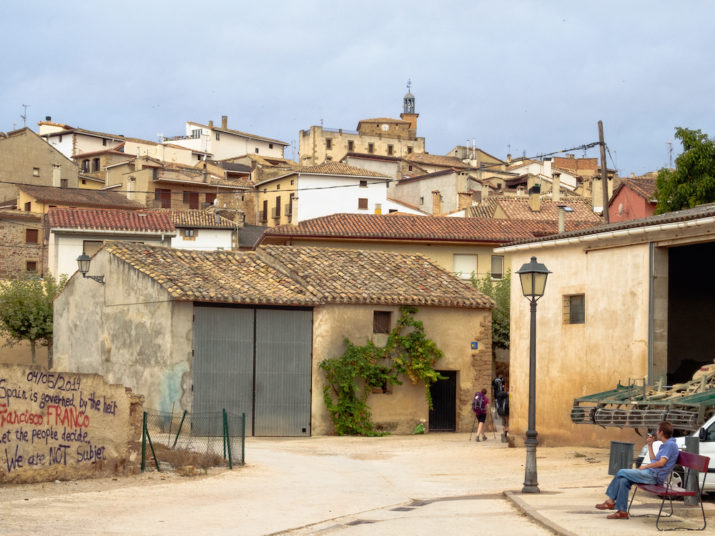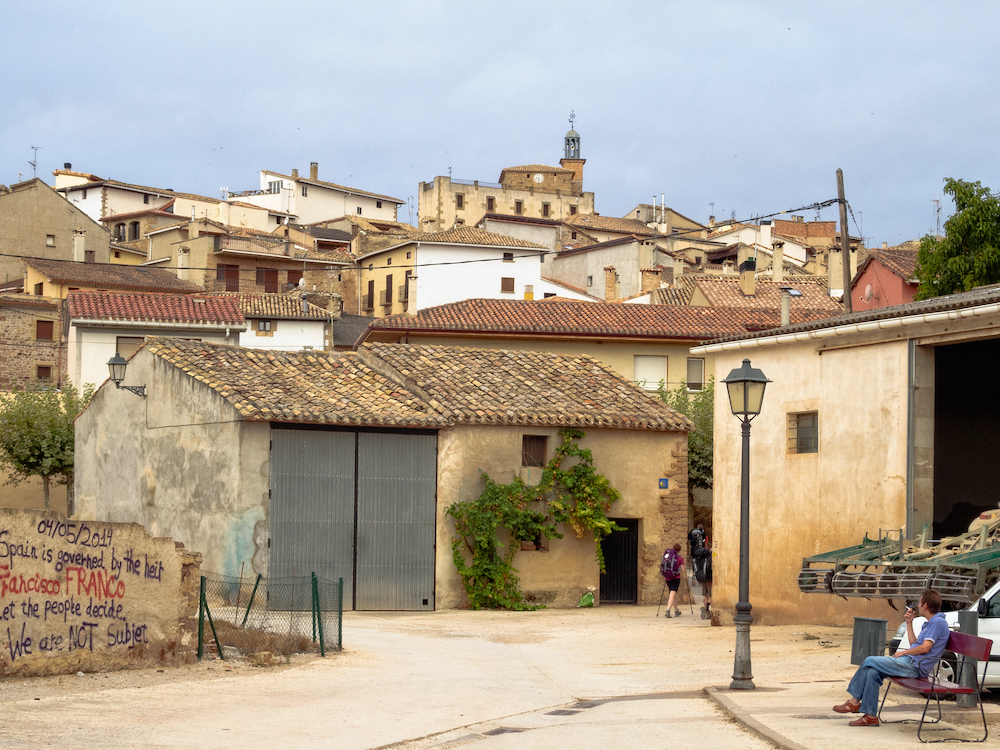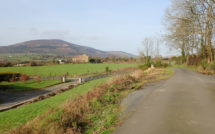

This is part of our special feature on Rurality in Europe.
La España vacia, “Empty Spain,” is the contentious, popular term summing up so much of the nation’s countryside today: thousands of villages left with no inhabitants or only a few. For at least the last seventy years, waves of villagers have emigrated to cities to fulfill a dream of a better life and better chances for their children. Moreover, the frustrated locals remaining in the villages started to organize and protest their neglected lot starting in the mid-2010s, succeeding in pushing their concerns onto the national agenda. The new coalition government, installed in January 2020, asserts that it is taking their arguments into consideration. Even so, the scene has only very recently become further complicated by the rise into visibility of a doubly-neglected group: rural women have begun to make themselves heard.
In the mid-1980s, I lived for two years in Cirauqui, a village thirty kilometers south of Pamplona, and have continued to visit ever since, albeit sporadically. Though numbers had been declining for years, there were still several hundred year-round residents. The agricultural way of life remained lively, though slowly shifting from a yeoman economy to one of a few farmers with large landholdings. I came to know several middle-aged women, the wives of smallholders. They often complained about their lot: “Wives are treated worse than cows! Our husbands pay more attention to their animals than to us!” In many families, the most promising son had inherited most of the household estate, so that property-less women had moved into the transgenerational home of their husbands once married. There, they had had to be subservient to their parents-in-law. The women argued that they were obliged to assist their husbands in whatever agricultural task they could, as well as run the home and raise children. If a couple kept cows (usually in the basement) and sold some of the milk locally, every day the women were expected to rise early and go to bed late. Keeping the home clean and odor-free was also a constant struggle. They married at a time when Franco’s dictatorship continued to propagate a strict sexist hierarchy. In the village, “heads of household,” as they were known, were supposed to be dominant, and some fathers or fathers-in-law took this as granting license to domineer. “One father was so controlling he would even choose his daughters’ knickers!”
In popular representations, village mothers have often been portrayed as the central upholders of traditional rural values. They were the ones, an ideological line ran, who exemplified and transmitted a longstanding, much-cherished morality of love and mutual support. Taught to emulate the Blessed Virgin, they were meant to take what comfort they could from their willing, silent self-sacrifice, performed for the sake of others. Many did. But others, once provided with the opportunity, regarded rural flight as an escape from agricultural drudgery. Some, especially the younger ones, regarded village morality as less a source of virtue, and more an over-extended mode of social control, with co-residents constantly observing and judging one another (Oliva and Camarero 2002, 71-72). I was told that a good number in the village attended Sunday Mass mainly to avoid provoking judgement. Impatient for broader horizons, these frustrated women wished to leave what they felt was a suffocating local ambience. In cities, they could choose to re-make themselves: free from in-law or neighborly oversight, they could indulge in a different range of pleasures, learn how to use money, form new circles of friends, consider new kinds of jobs. It was as though “the air was made of pure liberty” (Gancedo 2015, 148).
In contrast, men who comment on depopulation tend to concentrate on the perceived benefits of male urban waged labor as a main motivator for moving into town. They make no (or rare) mention of wives as key participants in family debates about whether to make the life-changing shift. When, on a return visit to Cirauqui, in the early 2010s, I asked female friends, most of them now in their late forties, about the various members of the age-group I was part of, they responded that many had moved to Pamplona where the men and some of the women held down jobs. They mentioned that some men who had declared they would never leave the village now worked in the city, though it was a car journey of little more than thirty minutes. The women I interviewed opined that these men had only left because their wives, many of whom were also from the village or nearby, had insisted on leaving rural life. They would, however, return, but only forthe weekends and the summer school holidays.
As a general rule, the majority of rural emigrants were not men, but women: their desire to get out was that great. Their exit created complementary imbalances in the sex ratios of villages and cities. Already by 1991, in rural Spain, for those in their late thirties, there were over all 85 women for 100 men. In contrast, in urban Spain, for the same cohort, women outnumbered men by 105 to 100 (Pinilla and Saez n.d., 6). These imbalances could be extreme in certain regions. By the 2000s, in the villages of Castile and León, north central Spain, middle-aged men outnumbered women by five to one; in Valencia, this sexual difference in residence was two-thirds less, because, it is argued, the Levantine job market traditionally offered more diverse, and more salaried opportunities to women (Camarero and Sampedro 2008, 82-93). Similarly, what kind of woman migrated changed over time. In the mid-century, in Castile and León, the majority of female immigrants had relatively low levels of education and sought domestic positions. By the 1970s, those who left for the city tended to be women with more years of schooling, with aspirations of social mobility, and in the hope of pursuing a career. This migratory phase coincided with the rise of the tertiary and service sectors within the national economy (Camarero and Sampedro 2008). In northern Navarre, not many women migrated to Pamplona in the immediate postwar decades: the general area was still mainly agricultural. The women who did make the shift, from the 1970s on, tended to be those of the next generation: better educated, more aware of sociocultural change, and able to apply for salaried jobs in the newly industrializing centers of the province (Cosín & Mauleón 1996, 151-153). In 2017, the proportion of women to men, nationwide, in Spanish municipalities of less than 100 inhabitants was 43 to 57.[1]
My women friends in Cirauqui were not surprised that the sex demographic of the village was becoming lop-sided. Several would note how many smallholders were ageing bachelors, and ask me, “Who wants to marry a farmer?” A bar in suburban Pamplona was nicknamed La ultima oportunidad, “The last chance,” as it was said middle-aged singleton farmers went there in the hope of meeting a life partner. In Cirauqui, one woman drily noted to me that the business reputed to be the most profitable in the village was its brothel: the end half of a large bar on the outskirts, it bordered the main road, easily accessible from any of the numerous hamlets nearby. I was taken in once: single mothers from Africa or Latin America in lingerie serving quiet farmers spending their meagre income. It was the most depressing place I visited in all my time there.
Several commentators speak of la España abandonada, “abandoned Spain.” Some villagers do feel left behind, betrayed by departing youth, for reasons they do not comprehend. But some do not feel that way. As Virginia Mendoza, a popular ethnographer, underlines, some villagers regard depopulation not as departure but as an ever more evident statement of their permanence: the ones who remain have decided to stay, to retain witness of a customary way of life. They will not put aside their sense of belonging, grounded on history, family, and sustained practices; they commit to dying where they were born, and take pride in that (Mendoza 2017). And since women tend to outlive men, it is the widows above all who act as sentinels for their villages and their memories. Perhaps the most publicized example of such rationale was the protest by the sole remaining villager in Foncebadon, who stood on the church roof to prevent the police from removing its bell to forestall its theft. While throwing the odd stone at the representatives of authority, she shouted that, come the day, it would toll for her, as it had done for her late kin and neighbors. She would not be cheated of her right. The bell remained (Llamazares 1993).
The recent emergence of la España vacía as a topic of national debate has led to the publication or re-edition of books on rural life. Many are well-selling portrayals, sticky with nostalgia, of extinct customs and now people-poor villages, for example: Alejandro López’s poetical tributes about past times in the province of Córdoba (López Andrada 2017, 2018); or Avelino Hernández’s tour of Castile, Donde la Vieja Castilla se acaba: Soria, praised today as a “classic, … a declaration of love, a poetic introspection, … an exaltation of everything in literature which is mysterious and moving” (Llamazares 2015: 10). And these are just three out of a library-full of romantic laments to a disappeared way of life. Analysts of rural emigration often jibe at these dulcified accounts. But, however incisive their views or broad their vision, these hasty critics may still be blind to their own biases.
It seems too many of these men writers do not realize how androcentric their focus is and how much they have failed to take women into account. For example, the major works of Jaime Izquierdo, prize-winning author on rural/urban relations, are fulsome, considered, and suggestive, but still mute on women (Izquierdo 2012, 2019); Paco Cerdà’s well-regarded travel account of visiting emptied villages is full of informative chats with villagers, but only one of them was female, an aged widow returning with the author to her former home to show him what had been lost (Cerdà 2017, 153-163). Women Spanish academics speak of the “incomprehensible historiographic silence” that still exists in relation to working countrywomen (Ortega López 2015; also García Roces 2017, 8). I do not dispute that statement.
Women’s contribution to rural life has been downplayed because they themselves downplayed it. They were trained to suffer in silence, taught to bear their sorrows internally, not bare them to all. They were not expected to hold forth in public settings, let alone represent the village to outsiders (Christian 1972; Lisón Tolosana 1966). Moreover, given the education then available, many of them could not write. One old man from Castile, when interviewed in the mid-2010s, by a cultural journalist, remembered the hard life his mother had endured and complained, “It offends me when on the radio or the television they keep on repeating that phrase ‘the working mother of today’” (Gancedo 2015, 72). It is as though the presenter failed to comprehend just how hard rural mothers had toiled. For, in the words of another interviewee, their mothers “lived as though genuinely cursed” (ibid: 130). And for many husbands, women’s work was not seen as work; according to the values in which they had been raised, the only labor recognized as such was that performed by men. For a man, to be regarded as a trabajador (worker) was high praise, the hallmark for local masculinity. As a smallholder in Cirauqui said to me, “To be told a man is a good worker is all you need to know.” Since the early 2000s I have been doing fieldwork in a village of the Alicantine interior. During the summer of 2016, while chatting with me about a laborious home-improving task, the middle-aged assistant of the village ironmongers, spontaneously undercut my grumbles: Nada más noble que el trabajo (“Nothing more noble than work”). He would not have said that about a woman’s efforts. The tasks of men and women were different: each differently categorized and differently valued.
This male-centered bias in the valuation of sex-based labor appears to carry over into studies of Spanish migration. Too many academics in this scholastic field, whether Spanish or from outside the Peninsula, seem to reproduce the masculine values of those they study, and downplay the participation of women in many dimensions of rural adult life. This would not be the first time (e.g. MacClancy 1996). Yet when women’s contribution is belatedly recognized, the danger becomes that they are viewed in a standardizing mode. To combat this blinding uniformity, María Sánchez, veterinary surgeon and writer, stressed the opposite in her well-selling book, Tierra de mujeres (“Land of women”): “There is no single type of rural woman. Rural life is diverse, and does not have a single face or voice. Rural life is multiplicity” (Sánchez 2019, 70).
The rise of IT boosted this process. For the creation of the Web and associated social media have enabled greater communication between otherwise isolated female rural workers and opened up markets for the more entrepreneurial among them.[2] Groups such as Ramaderes de Catalunya (Catalan: “Livestockwomen of Catalonia”) and Ganaderas en Red (“Livestockwomen on the Net”) act as mutually supportive networks, using Facebook, Twitter, and other platforms to share information, praise the neglected, and organize campaigns, among other activities.[3] These groups tend to act regionally, but they link up with nationwide umbrella organizations. Federación de Asociaciones de Mujeres Rurales (FADEMUR) classes itself as “a progressive organisation which fights for the equality and advancement of all the women who live and work in rural settings.” It was created with the aim of reinforcing the work done by the local associations of rural women integrated into FADEMUR, as “we know that the more of us and the more united we are, the greater the force our claims for fundamental rights will have and the more possibilities we will have of influencing the design of public policies that are really adjusted to our needs.” [4]
The number of women registered as heading their own agricultural operation is rising noticeably, though the advanced age of the majority of them questions the survival of many of these businesses.[5] These women, unlike their predecessors, enjoy the interlocking benefits of a recent, more positive definition of rurality and of new feminine models appraising women’s work. Elena Cebrián, the politician appointed to run the Government department for Reto Demográfico (“Demographic challenge”), affirmed this year that there would be grants or other forms of aid aimed specially at rural women. She has yet to specify what these measures will be.[6]
In sum, at first, an important new debate within Spanish life threatened to smuggle in tired stereotypes: too many of its writer-protagonists stayed dumb about silenced village-women, kept quiet on those who escaped their rural confinement. Perhaps they were just too blinkered. Yet change, seemingly irreversible, has belatedly broadened the discussion. Whether the efforts of today’s livestock women, female farmers, or artisanal producers provide fit rewards, whether younger women imitate their example, they are working to be heard. They should no longer be ‘the missing voices’ of the Spanish countryside.
Jeremy MacClancy is Professor of Social Anthropology, Oxford Brookes University. His book, The political agency of British migrants: Brexit and belonging, co-authored with Fiona Ferbrache, will be published by Palgrave in Autumn 2020. He also edited Alternative countrysides. Anthropological approaches to rural Western Europe today (Manchester University Press, 2015).
Read a previous article by Jeremy MacClancy about España vacia in EuropeNow here: https://www.europenowjournal.org/2020/06/02/an-empty-spain-filled-with-ideas/
References:
Camarero, Luis, and Rosario Sampedro. 2009. “?Porque se van las mujeres? El continuum de movilidad como hipótesis explicative de la masculinización rural.” Revista Española de Investigaciones sociológicas, 124: 73-105
Cerdà, Paco. 2017. Los últimos. Voces de la Laponia Española. Logroño: Pepitas de Calabaza.
Christian, William A. 1972. Person and god in a Spanish mountain valley. London: Seminar Press.
Cosín Reta, Jone, and Amaia Mauleón Martínez. 1996. “La mujer en el medio rural: una experience en Navarra.” In Intervención y diseños rurales (campesinos, bienestar social y anthropología), edited by Kepa Fernández de Larrinoa, 149-166. Vitoria: Universidad del País Vasco.
Gancedo, Emilio. 2015. Palabras mayores. Un viaje por la memoria social. Logroño: Pepitas de Calabaza.
García Roces, Irene. 2017. “Prólogo.” In Vidas a la intemperie. Nostalgias y prejuicios sobre el mundo campesino, edited by Marc Badal Pijoan, 7-9. Logroño: Pepitas de Calabaza.
Guiu Aguilar, Victor Manuel. 2019. Lo rural ha muerto. Viva lo rural. Otro puñetero libro sobre la despoblación. Teruel: Dobleuve Comunicación.
Izquerido Vallina, Jaime. 2012. La casa de mi padre: manual para la reinserción de los territories campesinos en la sociedad contemporánea. Oviedo: KRK Ediciones.
— 2019. La ciudad agropolitana, la aldea cosmopolita. Oviedo: KRK Ediciones.
Lisón Tolosana, Carmelo. 1966. Belmonte de los Caballeros. A sociological study of a Spanish town. Oxford: Oxford University Press.
Llamazares, Julio. 1993. ‘Las campanas de Foncebadón’, El País. 25 March, 1993. Available at https://elpais.com/diario/1993/03/26/opinion/733100401_850215.html (Accessed 4 x 2020)
— 2015. ‘Un clásico (ya) de la literature castellana y española’, in A. Hernández, Donde la vieja Castilla se acaba: Soria, 7-10. Leon: Rimpego.
López Andrada, Alejandro. 2017. El viento derruido. La España rural que se desvanece. Córdoba: Almuzara.
— 2018 Los años de la niebla. Los últimos pastores. Córdoba: Almuzara.
MacClancy, Jeremy. 1996. “Female bullfighting, gender stereotyping, and the State.” In Sport, identity, ethnicity, edited by Jeremy MacClancy, 70-85. Oxford: Berg.
Mendoza, Virginia. 2017. Quién te cerrará los ojos. Historias de arraigo y soledad en la España rural. Madrid: Libros de K.O.
Oliva, Jesús, and Luis A. Camarero. 2002. Paisajes sociales y metáforas del lugar. Pamplona: Universidad Pública de Navarra.
Ortega López, Teresa María, ed. 2015. Jornaleras, campesinas y agricultoras. La historia agrarian desde una perspectiva de género. Zaragoza: Prensas de la Universidad de Zaragoza.
Pinilla, Vicente, and Luis Antonio Sáez. n.d. La despoblación en España: genesis de un problema y políticas innovadoras. N.p.: SSPA Áreas escasamente pobladas de sur de Europa. Available at http://sspa-network.eu/wp-content/uploads/Informe-CEDDAR-def-logo.pdf
(Accessed 5 x 2020)
Sánchez, María. 2019. Tierra de mujeres. Una mirada íntima y familiar al mundo rural. Barcelona: Seix Barral.
[1] “La España vacía y vaciada de mujeres: cinco gráficos que explican el doble drama.” El economista, January 2020. Accessed 6 x 2020. https://www.eleconomista.es/economia/noticias/10318148/01/20/La-Espana-vacia-y-vaciada-de-mujeres-cinco-graficos-que-explican-el-doble-drama.html
[2] E.g. the e-market for artisanal products produced in Spain created by the national Post Office, Correos Market. See “Tecnología contra la despoblación rural.” El País, Retina supplement, 29 I 2020. Accessed 6 x 2020. https://retina.elpais.com/retina/2020/01/29/innovacion/1580299780_031730.html
[3] For further information on these, see https://www.facebook.com/pages/category/Personal-Blog/Ramaderescat-787838001413853/ ; and
http://www.ganaderasenred.org/ Both accessed 4 x 2020
[4] “Quiénes somos.” FADEMUR. http://fademur.es/fademur/quienes-somos/ Accessed 3 x 2020. For an example of the work of FADEMUR, see Gorka Alonso Gil. 2020. “Mujeres rurales: el reto de emprender en el campo.” El Mundo, 9 vii 2020. Accessed 6 x 2020. https://efectopositivo.elmundo.es/comprometidos/mujeres-rurales-el-reto-de-emprender-en-el-campo?follow=1
[5] “Las mujeres se reivindican como el freno a la ‘España vacía.’” El Ágora. Diario del agua, October 2019.Accessed 6 x 2020. https://www.elagoradiario.com/desarrollo-rural/mujeres-rurales-freno-espana-vaciada/
[6] “Elena Cebrián: ‘Habrá ayudas para jovenes y mujeres en la España rural.’” El País,29 ii 2020. Accessed 6 x 2020. https://elpais.com/sociedad/2020-02-28/elena-cebrian-habra-ayudas-para-jovenes-y-mujeres-en-la-espana-rural.html?fbclid=IwAR1b_5qJG3TQscooncpHzr8ezATO_ucDjeFQoxZiFv6pNMQ4R4wSOaVrExI
Photo: Photo: Cirauqui, Navarre, Spain – September 6, 2014: Pilgrims arrive at the hilltop village Cirauqui | Shutterstock
Published on November 10, 2020.




